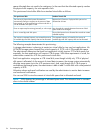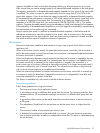capacity available to create virtual disks decreases. Before you allocate space for new virtual
disks, ensure that you reserve enough space for all demand-allocated snapshots in the disk group.
The capacity required for a demand-allocated snapshot depends on how much of the source disk
is modified. This value is unique for each application, but can range from 0% to 100% of the
source disk capacity. If you do not know the capacity required for a demand-allocated snapshot,
HP recommends that you reserve a minimum of 10% of the capacity of the source virtual disk times
the number of snapshots of the source disk. For example, if you have two demand-allocated
snapshots of a 500 GB virtual disk, you would reserve 100 GB (500 GB x 10% x 2) of usable
capacity. Compute the usable capacity using the redundancy (Vraid) level selected for the snapshot.
If the availability of demand-allocated snapshots is critical for application availability, overestimating
the requirements for free space may be warranted.
Always monitor free space. In addition to demand-allocated snapshots, a disk failure and the
subsequent reconstruction can also compete for free space. After a reconstruction, the reserved
space requirements for the disk protection level can cause existing snapshots to exceed available
free space and thus cause all snapshots to become inoperative.
Mirrorclones
Mirrorclone replication establishes and maintains a copy of an original virtual disk via a local
replication link.
When a mirrorclone contains exactly the same data as the source virtual disk, the mirrorclone is
said to be synchronized. In a synchronized state, the mirrorclone is automatically updated whenever
the source virtual disk is updated.
When local replication between a synchronized mirrorclone and its source is stopped by the user,
the mirrorclone is said to be fractured. In a fractured state, the mirrorclone is not updated when
the source virtual disk is updated. At the instant replication is stopped, the mirrorclone is a
point-in-time copy of its source. Although a fractured mirrorclone is no longer being replicated, it
maintains a relationship with its source virtual disk. This allows the mirrorclone to resynchronize
with its source without requiring a complete resynchronization.
When the relationship between a fractured mirrorclone and its source virtual disk is severed, the
mirrorclone is said to be detached. A detached mirrorclone is an independent virtual disk and
cannot be reattached to its parent virtual disk.
This feature is available only with certain controller software versions.
Mirrorclone guidelines
Follow these guidelines for using mirrorclones:
• The array must have a local replication license.
• A mirrorclone can be in a different disk group than the source. For optimum protection from
hardware failures, HP recommends creating a mirrorclone in a different disk group than the
source.
• A mirrorclone delta restore can be made when the mirrorclone source is also the source for
a DR group.
• The redundancy (Vraid) level of a mirrorclone can be the same, lower, or higher than the
source.
• The maximum number of mirrorclones per source is one.
• A detached mirrorclone cannot be reattached to its source. (You can remove a mirrorclone
from its source virtual disk, to make it an independent virtual disk. This action is called detaching
the mirrorclone.)
HP P6000 Business Copy software 37


















